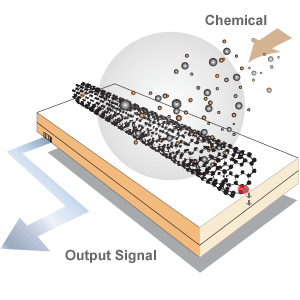 Chemical sensors are used for many purposes, such as environmental hazard screening, explosives detection, product characterization, and medical testing. The electronic properties of SWNTs can change significantly when gases and bio-molecules are adsorbed to their surface. These changes can be detected in resistor, transistor, or capacitor devices.
Chemical sensors are used for many purposes, such as environmental hazard screening, explosives detection, product characterization, and medical testing. The electronic properties of SWNTs can change significantly when gases and bio-molecules are adsorbed to their surface. These changes can be detected in resistor, transistor, or capacitor devices.
A principle advantage of TFT SWNT sensors in particular is that they respond to analyte surface coverage, as opposed to conventional sensors, which respond to analyte concentration. SWNT TFT sensors are thus well-suited for detecting chemical weapons agents and explosives, which typically occur in low concentrations in situ.
Demonstrated Results Using Sorted Nanotubes
NanoIntegris-based materials have been used to produce over 300 different types of sensors! In the realm of biosensing our IsoNanotubes M and S solutions were most recently used as biosensors with Glucose Oxidase and Dehydrogenase (Muguruma et. al, ACS Appl. Mater. Interfaces, 2015) while our 99% IsoNanotubes-S solution has been utilized in the thin film transistor to serve as a label-free biosensor for the detection of biotin and streptavidin (Lamberti, et. al, Nanotechnology, 2014), and the Iso-S 98% SWNT”s have been utilized in a DNA-Carbon nanotube vapor sensor to analyze sweat simulant mixtures (Kybert, et. al, Journal of Forensic Science, 2014).
Additionally, our Iso-S SWNTs have been effectively used in carbon monoxide (Yang, et. al, Nanotechnology, 2013) and hydrogen sulfide (Jung, et. al, Analyst, 2013) detection at ppb levels.